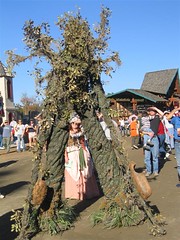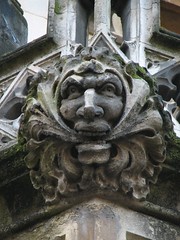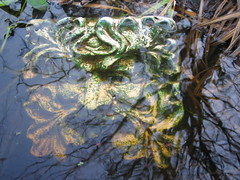
And I can't resist showing you the exquisite carving of the whole doorway:

(You may guess there will be a post dedicated to this amazing church in the near future).
Where to start? The Green Man obviously has Pagan origins. He is linked in folklore to Jack-in-the-Green/Green Jack/John Barleycorn, who is connected with Maytime and midsummer celebrations. He is also associated with Mummers and Morris Dancers. The power and rebirth of the greenwood was celebrated on May Day. In the village of Great Wishford in Wiltshire, on the 29th May, the villagers go to Grovely Woods to collect wood, a right given them in 1603. They return bearing large branches of oak and chanting "Grovely, Grovely, and all Grovely" and bearing a banner with the same words on it. It seems a late date, but I would suspect may have much earlier Pagan origins, possibly connected with the Green Man/Jack-in-the-Green folklore.

 We still have an intense desire to recreate the past. The lower Green Man is from Ren Faire.
We still have an intense desire to recreate the past. The lower Green Man is from Ren Faire.The general theme is the same - a male human face (I believe Green Women are virtually unheard of), with foliage for hair, beard, and often protruding from the mouth or sometimes eyes or nostrils, and sometimes decorated with fruit or flowers. They are a definite part of Church architecture as well as appearing on secular buildings. It is a motif which appears in many cultures around the world, celebrating spring and rebirth. The actual term "Green Man" can be laid firmly at the feet of Lady Raglan, who called such carvings thus in her article on the subject for the Folklore Journal in 1939. The Green Man has, I believe, connections with the wild man of the woods - the Woodwose.
 With the Renaissance, the Green Man found himself almost reinvented, and being used in illustrations as part of metalwork, manuscripts, stained glass and bookplates, never more so than in the Gothic Revival at the time of the Arts and Crafts movement, when he was often to be seen adorning the architecture of the period. He is enjoying another renaissance in art and sculpture, and my husband bought me a little Green Man sculpture for my birthday, when we were at Raglan Castle earlier this week.
With the Renaissance, the Green Man found himself almost reinvented, and being used in illustrations as part of metalwork, manuscripts, stained glass and bookplates, never more so than in the Gothic Revival at the time of the Arts and Crafts movement, when he was often to be seen adorning the architecture of the period. He is enjoying another renaissance in art and sculpture, and my husband bought me a little Green Man sculpture for my birthday, when we were at Raglan Castle earlier this week. Here is a Continental Green Man from Prague.
Here is a Continental Green Man from Prague. This fiercer face is from Pembroke College, Oxford.
This fiercer face is from Pembroke College, Oxford. A modern rendition and you can't help smile at him!
A modern rendition and you can't help smile at him! This one is in the Quire stalls at Winchester Cathedral.
This one is in the Quire stalls at Winchester Cathedral. This one is at Rosslyn Chapel (of Da Vinci Code fame) - not the prettiest Green Man I've ever seen!
This one is at Rosslyn Chapel (of Da Vinci Code fame) - not the prettiest Green Man I've ever seen! There are even Green Cats. These were popular from about the 12th C onwards, and probably copied from the cats which appear in illustrated manuscripts. Apparently linked cats form a border around the font at Lullington, Somerset.
There are even Green Cats. These were popular from about the 12th C onwards, and probably copied from the cats which appear in illustrated manuscripts. Apparently linked cats form a border around the font at Lullington, Somerset.There are many derivatives and relations of the Green Man, Wikipedia names a few: http://en.wikipedia.org/wiki/Green_Man
and it is interesting that Father Christmas was originally clothed in green (or sometimes purple) before Coca Cola got hold of him!

A Green Man in reflective mode . . .

